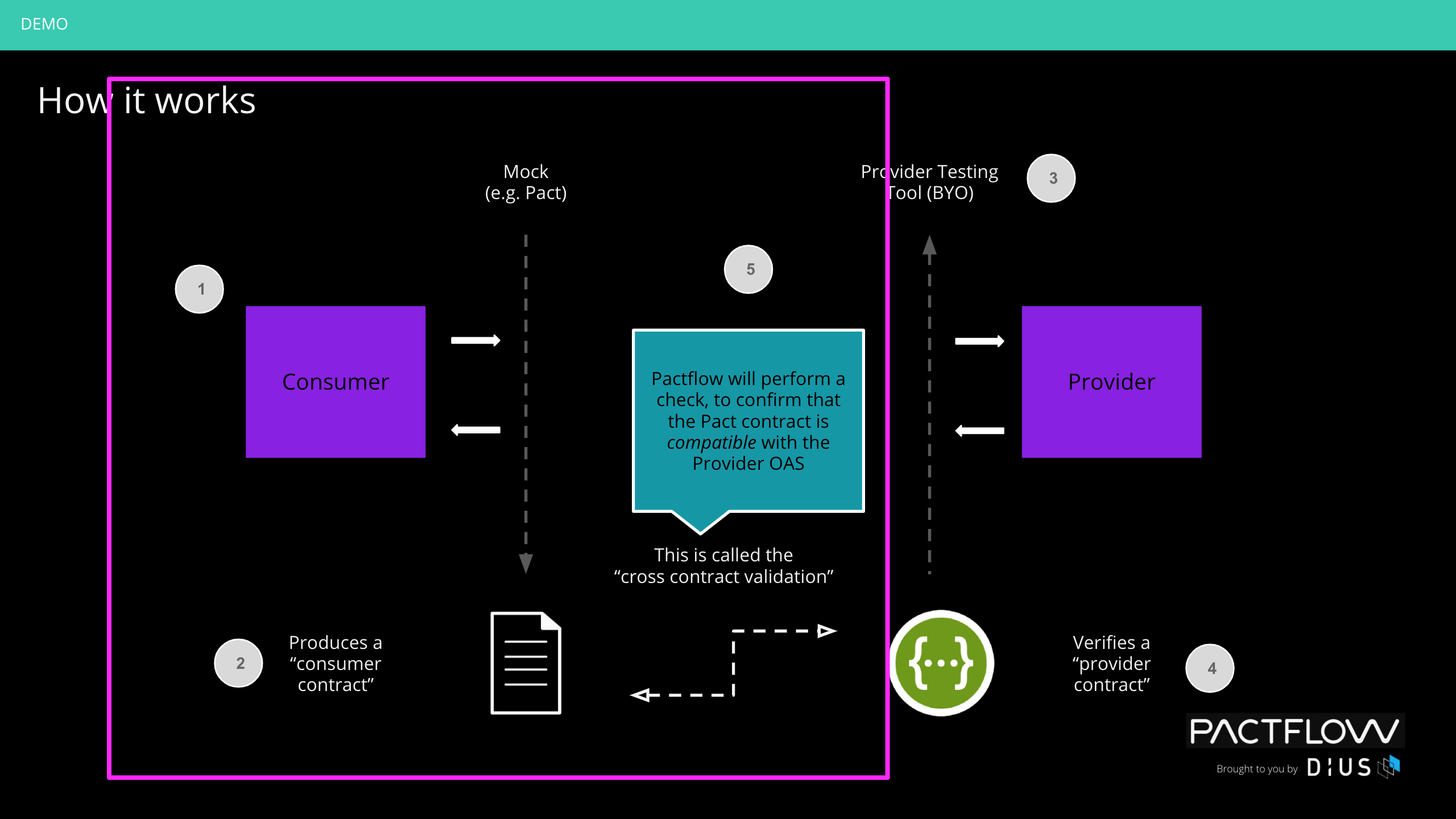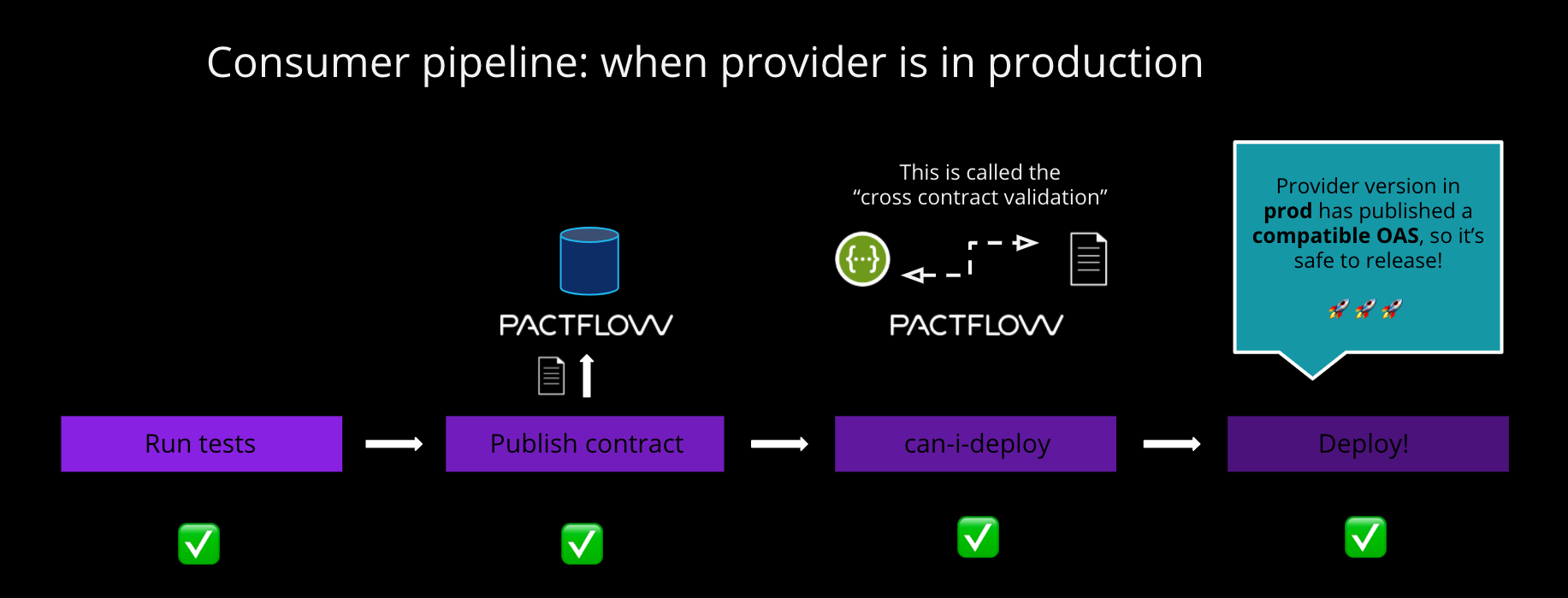Example Java Consumer - Wiremock (BYO Adapter)
Source Code
https://github.com/pactflow/example-bi-directional-consumer-wiremock
Overview of Example
This is an example of a Java "Product" API consumer that uses Wiremock, Pact, PactFlow and GitHub Actions to generate and publish Pact consumer contracts.
It performs pre-deployment cross-compatibility checks to ensure that it is compatible with specified providers using the Bi-Directional contract capability of PactFlow.
See the full PactFlow Bi-Directional Workshop for which this can be substituted in as the "consumer".
Overview of Part of Bi-Directional Contract Testing Flow
In the following diagram, You can see how the consumer testing process works - it's the same as the current Pact process.
When we call "can-i-deploy" the cross-contract validation process kicks off on PactFlow, to ensure any consumer consumes a valid subset of the OAS for the provider.

The project uses a Makefile to simulate a very simple build pipeline with two stages - test and deploy.
When you run the CI pipeline (see below for doing this), the pipeline should perform the following activities (simplified):
- Test
- Run tests (including the pact tests that generate the contract)
- Publish pacts, tagging the consumer version with the name of the current branch
- Check if we are safe to deploy to Production with
can-i-deploy(ie. has the cross-contract validation has been successfully performed)
- Deploy (only from master)
- Deploy app to Production
- Record the Production deployment in the Pact Broker

Compatibile with Providers
This project is currently compatible with the following provider(s):
- pactflow-example-bi-directional-provider-dredd
- pactflow-example-bi-directional-provider-restassured
- pactflow-example-bi-directional-provider-postman
See Environment variables on how to set these up.
Pre-requisites
Software:
- Tools listed at: https://docs.pactflow.io/docs/workshops/ci-cd/set-up-ci/prerequisites/
- A pactflow.io account with an valid API token
Environment variables
To be able to run some of the commands locally, you will need to export the following environment variables into your shell:
PACT_BROKER_TOKEN: a valid API token for PactFlowPACT_BROKER_BASE_URL: a fully qualified domain name with protocol to your pact broker e.g. https://testdemo.pactflow.io
Set PACT_PROVIDER to one of the following
PACT_PROVIDER=pactflow-example-bi-directional-provider-dredd: Dredd - (https://github.com/pactflow/example-bi-directional-provider-dredd)PACT_PROVIDER=pactflow-example-bi-directional-provider-postman: Postman - (https://github.com/pactflow/example-bi-directional-provider-postman)PACT_PROVIDER=pactflow-example-bi-directional-provider-restassured: Rest Assured - (https://github.com/pactflow/example-bi-directional-provider-restassured)
NOTE:- It defaults to pactflow-example-bi-directional-provider-restassured for compatibility with the Java RestAssured provider
Usage
Steps
make test- run the tests locallymake fake_ci- run the CI process, but locally
OS/Platform specific considerations
The makefile is configured to run on Unix based systems such as you would find in most common CI/CD pipelines.
They can be run locally on Unix/Mac, or on Windows via WSL2.
Windows
You can still try this example locally on Windows using powershell and running commands manually.
Click to see windows specific instructions here
These will be the same commands that are used in the makefile with a few manual tweaks.
Make sure you have set all of the environment variables, in powershell they can be set like so.
$env:GIT_BRANCH="main"Publish the pact that was generated. The step uses the pact-cli docker image to publish the pact to your pactflow account. The path for
<path_to_project_root>needs to be converted from Windows paths to UNIX ones as the Docker container is using UNIX. Either hard code this or set it as another environment variable.`C:\Users\Person\Documents\example-bi-directional-consumer-dotnet`
becomes
`/c/Users/Candy/Documents/PactFlow/example-bi-directional-consumer-dotnet`
$env:VARIABLE_NAME refers to the environment variables in windows.
```
docker run --rm -v <path_to_project_root>:<path_to_project_root> -e PACT_BROKER_BASE_URL -e PACT_BROKER_TOKEN pactfoundation/pact-cli publish <path_to_pacts_folder> --consumer-app-version $env:GIT_COMMIT --branch $env:GIT_BRANCH
```Check can-i-deploy to see if your provider is compatible with your pact.
docker run --rm -v <path_to_project_root>:<path_to_project_root> -e PACT_BROKER_BASE_URL -e PACT_BROKER_TOKEN pactfoundation/pact-cli broker can-i-deploy --pacticipant pactflow-example-bi-directional-consumer-dotnet --version $env:GIT_COMMIT --to-environment production --retry-while-unknown 0 --retry-interval 10Have a look at what other commands are available in the Makefile. All of them can be ran locally from Powershell by changing the windows paths to UNIX and replacing the environment variable references. Any variable referenced as
${VARIABLE}can be changed to$env:VARIABLEto reference environment variables in Powershell.
Caveats
Related topics / posts / discussions
- Consumer Side Bi-Directional Contract Testing Guide
- Provider Side Bi-Directional Contract Testing Guide
Other examples of how to do this form of testing
- TBC
Found an issue?
Reach out via a GitHub Issue, or reach us over in the Pact foundation Slack